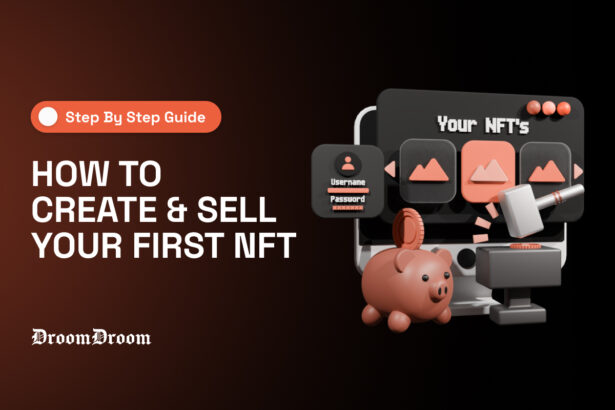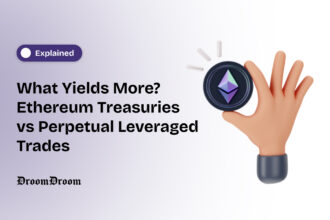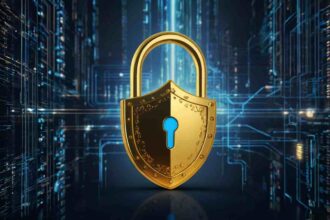Ever imagined your digital creations could be as precious as the One Ring from The Lord of the Rings? In this guide on how to create and sell your first NFT, we’ll explore the process that allows artists, creators, and collectors to unlock new opportunities for digital ownership.
Non-Fungible Tokens (NFTs) are where artists, creators, and collectors open doors to new forms of ownership.
These mysterious, often glamorous tokens promise artists, creators, and dreamers alike the thrill of turning digital art into collectible, tradeable assets.
If you’ve watched “Inception,” think of NFTs as a way to layer ownership within a digital universe. And like Leonardo DiCaprio’s character, who dives into the subconscious to plant ideas, you’ll dive into the blockchain to immortalize your art in an unbreakable chain of digital proof.
Creating and selling your first NFT involves selecting digital content, choosing a blockchain and marketplace, setting up a crypto wallet, and minting the NFT for sale. To start, select an artwork or digital file you own, and decide on a blockchain like Ethereum or Polygon for storing your NFT. Set up a compatible crypto wallet (e.g., MetaMask), then choose a marketplace such as OpenSea or Rarible where you’ll list and sell the NFT.
Let’s unravel this step-by-step journey through creating and selling your first NFT.
What Is an NFT?
Before setting off on this journey, let’s clear the air around NFTs. An NFT, or Non-Fungible Token, is a unique digital asset stored on a blockchain—a decentralized ledger that transparently records transactions. Unlike interchangeable cryptocurrencies like Bitcoin or Ethereum, NFTs are one-of-a-kind assets.
An NFT represents ownership of a specific digital asset, whether it’s a piece of art, music, a video, or even a tweet. As a creator, minting an NFT places your work on a blockchain, where it will remain untouched, with your ownership proven by this digital ledger.
NFTs date back to 2012 with “colored coins” on Bitcoin, small portions of Bitcoin marked with distinct information representing real-world assets.
Since then, NFTs have come a long way, evolving into million-dollar artworks and a collectible frenzy in digital marketplaces like OpenSea, Rarible, and Foundation. Creating and selling your first NFT means placing your digital content on the blockchain, making ownership indisputable.
Step 1: Select Your Artwork
Your journey to create and sell your first NFT begins with selecting the digital content you want to tokenize. NFTs are versatile, allowing everything from digital art and catchy tunes to rare in-game items to transform into collectibles.
Think of Beeple, the digital artist who catapulted into fame after his NFT artwork sold for $69.3 million. Your artwork could be anything: a painting, a digital animation, music, a poem, or even a short video clip. The NFT world loves creativity, whether it’s classic art or digital extravagance.
As Harry Potter author J.K. Rowling once wrote, “Words are, in my not-so-humble opinion, our most inexhaustible source of magic,” and here, you’re infusing that magic into the digital ownership.
Remember, “beauty is in the eye of the beholder.” What matters most is that your work is original and you hold the rights to it—NFTs strictly respect intellectual property, and plagiarism can be a swift downfall in this space.
Step 2: Set Up a Digital Wallet
To create and sell an NFT, you’ll need a digital wallet to interact with the blockchain.
Before diving into the blockchain, you’ll need a digital wallet—your key to interacting with NFT platforms and holding the cryptocurrencies used in these transactions. Think of it as your personal bank in the NFT world.
MetaMask, a widely-used Ethereum-based wallet, is popular for its ease of use. Other options like Coinbase Wallet and WalletConnect can also serve as secure digital wallets.
After setting up, fund your wallet with some Ether (ETH), the cryptocurrency powering most NFT transactions on Ethereum. Gas fees, the transaction costs for minting and selling NFTs, are paid in ETH, which fluctuates with network activity.
Step 3: Select the Right Blockchain and Marketplace
Choosing the right blockchain is key when you create and sell your first NFT. Ethereum is the most popular choice, offering broad support and a bustling NFT ecosystem. However, it isn’t the only game in town—Polygon, Tezos, and Solana also support NFTs with their unique advantages.
Polygon, for instance, offers low or even gas-free transactions, which could be ideal for budget-conscious creators.
Once you’ve chosen a blockchain, you’ll need a marketplace. OpenSea is a leading marketplace for first-time creators, with tools that simplify the minting process. Rarible is another community-owned platform that allows creators to set royalties and offers options for multiple blockchains, like Ethereum and Tezos.
Step 4: Mint Your NFT
This is where the magic happens. “Minting” refers to creating an NFT on a blockchain, transforming your digital file into an asset that can be bought, sold, or traded. Imagine uploading your file onto OpenSea or Rarible, filling out details like the title, description, and a link to your website or social media if you wish.
To mint, simply hit “Create” on your chosen platform and upload your file in a compatible format (JPEG, PNG, MP4, MP3, etc.).
Choose your blockchain—Polygon if you want to skip the gas fees, or Ethereum if you’re aiming for the big league. Add in any attributes to increase its rarity and set the royalty fees, which give you a percentage each time your NFT is resold in the future.
Step 5: Price and List Your NFT for Sale
Once your NFT is minted, it’s time to put it on the market. You can list your NFT at a fixed price, like an item on eBay, or go for an auction format. Fixed-price sales are simple: set your price and wait for a buyer. In a timed auction, you set the bidding window, and the highest bidder wins when the timer runs out.
Platforms like OpenSea and Rarible allow you to specify whether your NFT is available to everyone or only to a specific buyer. You can also use “lazy minting” on platforms like Rarible, where the buyer covers the minting costs, allowing you to create NFTs for free.
Step 6: Promote Your NFT
NFTs don’t sell themselves. The community plays a big role here, and your job is to build one. Twitter, Discord, and Instagram are popular places for NFT enthusiasts and collectors to gather.
As Thao Nguyen, an Etsy-creator-turned-NFT-artist, explained, “We interact with each other every day…It’s a very giving relationship, and I absolutely love it.”
Collaborate with influencers and other artists, and join NFT groups where your work can gain visibility. Maliha Abidi’s “Women Rise” collection, for instance, garnered significant attention through grassroots support.
She recalls, “We have not put in even $1 in marketing so far, but we were literally just featured in Vanity Fair yesterday and today in Rolling Stone.”
Step 7: Manage Your NFT’s Financial Aspects
As you venture into the NFT space, be aware of fees involved. Gas fees on Ethereum can be pricey, fluctuating with network congestion, especially on weekends. Experts suggest minting late at night when fees drop.
For lower-cost options, consider gas-free minting on Polygon or Rarible’s free minting option, where the buyer covers gas fees.
Step 8: Protect Your Art and Yourself
Protecting your digital work is vital in the world of NFT creation and sales. NFTs can be stolen, duplicated, or pirated. As NBC News once reported, platforms like OpenSea have faced fraud cases, making it essential to monitor where and how your work appears online.
DeviantArt offers a helpful tool that scans the blockchain for illegal copies of artists’ work and alerts them. You can also send copyright notices to NFT platforms if you find unauthorized duplicates of your NFTs.
Conclusion
Creating your first NFT may feel like stepping through the wardrobe into Narnia—a bit mysterious, but full of wonder. By following these steps to create and sell your first NFT, you’ll be ready to turn your digital creations into valuable assets on the blockchain.
In the words of Dr. Seuss, “Why fit in when you were born to stand out?”
NFTs offer creators a new way to do just that, to forge their paths in a digital world and turn their creativity into something that lasts.



















